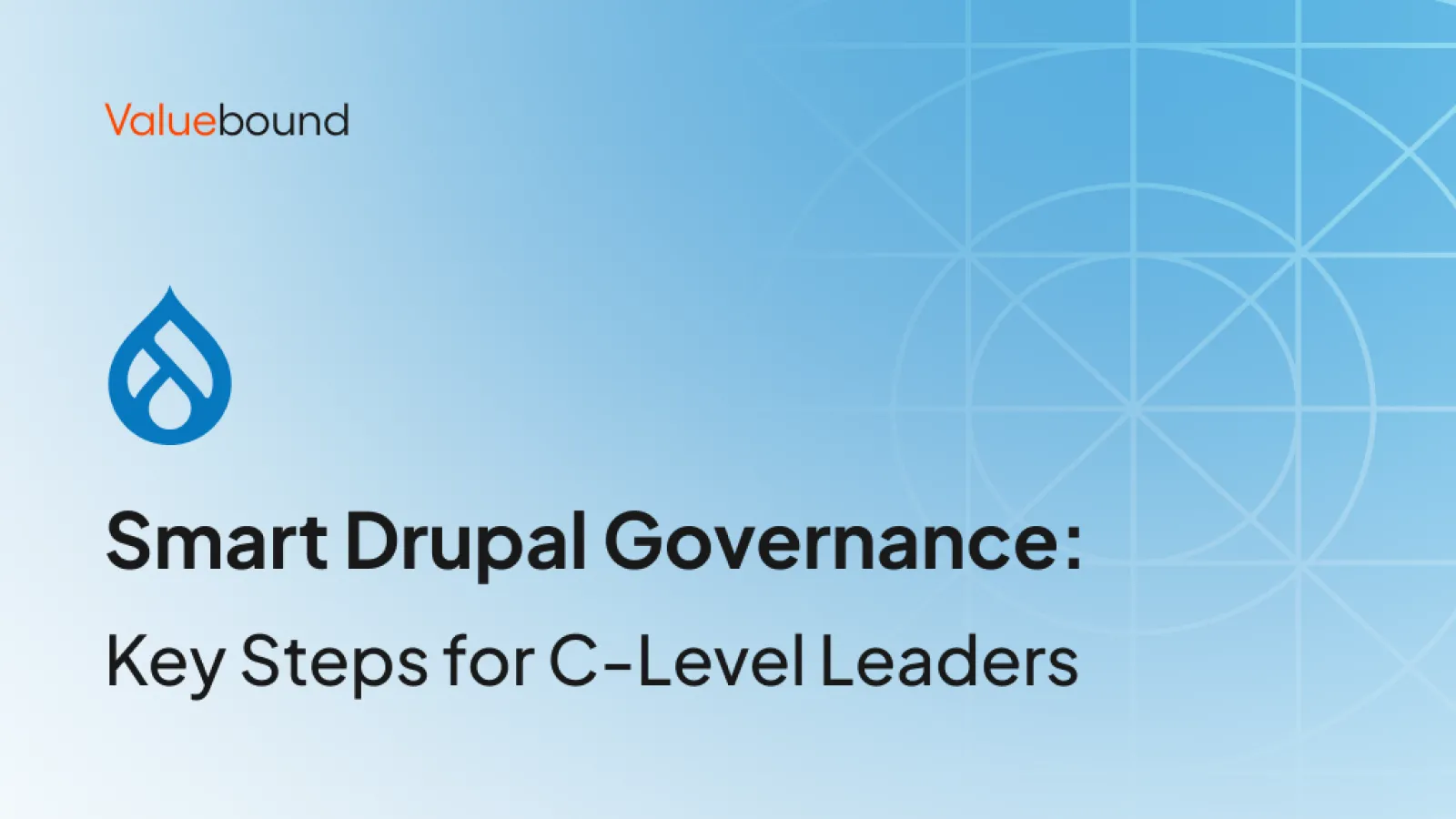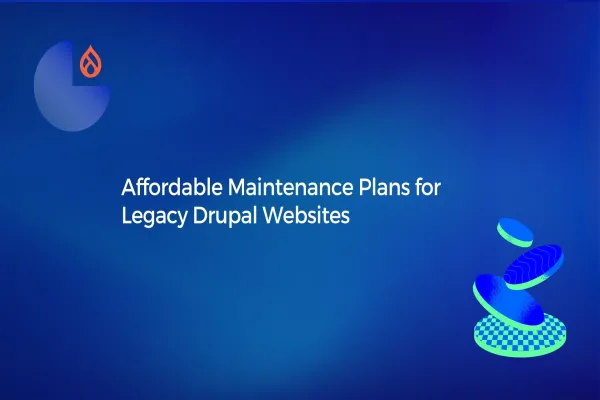How Enterprise Drupal Users Cut Maintenance Costs by 40% Through Smart Governance
Enterprise organizations managing large-scale Drupal installations face rising maintenance costs, inefficiencies, and challenges in governance. With businesses under increasing pressure to achieve more with less, smart governance emerges as a game-changing strategy, helping enterprises reduce maintenance costs by up to 40% while optimizing operational workflows. For C-suite executives, this is not just a technical initiative—it’s a business imperative. Here’s a comprehensive look at how smart governance drives measurable ROI for enterprises relying on Drupal.
Understanding the Problem: Drupal Maintenance at Scale
For organizations managing five or more Drupal sites, maintenance often turns into an operational and financial headache. Common pain points include:
- Redundant Efforts: Teams across departments or regions duplicate work, increasing costs.
- Compliance Challenges: Disparate governance leads to inconsistent adherence to regulatory requirements.
- Resource Strain: Developers waste time on manual updates and troubleshooting, rather than focusing on innovation.
Consider a global e-commerce company with 30 regional Drupal sites. The absence of a unified governance strategy resulted in inconsistent branding, prolonged update cycles, and ballooning operational costs. These inefficiencies eroded their competitive edge and strained budgets.
What Is Smart Governance?
Smart governance isn’t merely a buzzword; it’s a structured approach to managing Drupal ecosystems at scale. For C-suite leaders, smart governance offers:
- Centralized Oversight: A unified framework to standardize processes, ensuring consistency across all sites.
- Automation: Leveraging tools to handle routine maintenance tasks such as module updates and security checks.
- Policy-Driven Management: Defining clear workflows for content creation, updates, and compliance.
How Smart Governance Drives Cost Savings
Implementing smart governance unlocks significant cost efficiencies:
- Reduced Redundancy: By eliminating duplicate efforts and streamlining operations across sites.
- Optimized Resources: Automation frees up developers to focus on strategic projects, reducing reliance on high-cost resources for repetitive tasks.
- Enhanced Security: Centralized governance ensures consistent security protocols, reducing vulnerabilities and associated costs.
For instance, enterprises using tools like Composer Update Module for Drupal 10 save developer hours by automating routine updates. Similarly, Drupal Site Audit Tools identify inefficiencies in real time, enabling faster resolutions.
Case Study: Financial Services Transformation
A multinational financial services provider managing 20 Drupal websites faced escalating maintenance costs and compliance issues. After implementing smart governance with a focus on:
- Centralizing workflows,
- Automating updates, and
- Partnering with a Drupal specialist for tailored solutions,
they achieved a 40% reduction in annual maintenance costs and streamlined compliance with global regulatory standards. These savings were reinvested into innovation, improving their competitive edge.
Key Steps for C-Level Implementation
Transitioning to a smart governance model might seem complex, but with a structured approach, it can be manageable and highly rewarding. Here are the steps to get started:
1. Audit Existing Sites
Conducting regular Drupal audits is foundational for identifying inefficiencies, security vulnerabilities, and performance issues.
What to Audit?
- Compliance: Ensure adherence to industry regulations and internal policies, such as data privacy (e.g., GDPR, HIPAA).
- Performance: Analyze site speed, scalability, and server utilization to optimize the user experience.
- Content Management: Review outdated or irrelevant content to streamline workflows and maintain a cohesive brand message.
- Security: Check for unpatched modules, misconfigured permissions, and other vulnerabilities that could lead to breaches.
Best Practices for Drupal Audits:
- Use tools like Drupal Site Audit or Drupal Check for automated reporting.
- Schedule audits quarterly or before major platform upgrades.
- Involve cross-functional teams, including IT, marketing, and compliance, to ensure a holistic review.
2. Adopt Automation Tools
Automation is key to reducing manual effort, minimizing errors, and ensuring timely updates and maintenance.
Recommended Tools and Their Benefits:
- Drush: A command-line tool that accelerates site administration tasks like clearing caches, running updates, and managing users.
- Composer: A dependency manager that simplifies the installation and updates of Drupal modules, libraries, and themes.
- CI/CD Pipelines: Implement continuous integration and delivery workflows for smoother deployments and rollback options.
- Configuration Management System (CMS): Leverage Drupal's built-in configuration management tools to version control settings across environments.
Why Automation Matters for C-Level Executives?
Automation not only reduces overhead but also empowers teams to focus on high-value tasks such as strategy, innovation, and user engagement.
3. Centralize Oversight
Dispersed Drupal operations can lead to inconsistent branding, duplicated efforts, and governance blind spots. Centralizing oversight ensures alignment with enterprise objectives.
How to Centralize Oversight:
- Establish a Governance Committee: This cross-departmental team should include representatives from IT, marketing, legal, and operations to align governance policies across functions.
- Create a Unified Dashboard: Implement dashboards that consolidate performance metrics, user permissions, and audit logs for real-time insights.
- Define Clear Roles and Responsibilities: Assign ownership for critical tasks such as content approvals, site updates, and security monitoring.
Governance in Action:
For enterprises managing multiple brands or regions, centralization ensures consistency in content standards and prevents duplication of work, saving time and resources.
4. Leverage Expertise
Smart governance requires in-depth Drupal knowledge, which may not always be available in-house. Collaborating with experienced Drupal professionals can bridge this gap.
How Drupal Specialists Can Help:
- Governance Frameworks: Experts can design frameworks tailored to your organization’s size, structure, and regulatory requirements.
- Module Selection and Customization: Professionals can recommend or build modules that enhance governance, such as workflow automation tools.
- Training and Knowledge Transfer: Educating internal teams on best practices for maintaining Drupal sites and adhering to governance policies.
- Proactive Support: Providing ongoing support to monitor site health, implement upgrades, and address emerging challenges.
Selecting the Right Partner:
Look for development firms with a proven track record in Drupal governance, certifications like Acquia, and expertise in scaling enterprise websites.
The Role of Custom Drupal Solutions
Custom Drupal development further amplifies the ROI of smart governance. Tailored solutions—from automated workflows to scalable site architecture—empower enterprises to reduce costs and scale seamlessly. For example:
- Consolidating Legacy Sites: Migrating outdated sites to a single, scalable platform cuts hosting and maintenance expenses.
- Custom Automation Modules: Developing bespoke tools automates repetitive tasks, improving efficiency.
Overcoming Resistance and Initial Costs
Despite its benefits, implementing smart governance can face hurdles:
- Resistance to Change: Teams may hesitate to adopt new workflows or centralization.
- Initial Investment: Automation tools and expert consultations require upfront costs.
To address these challenges:
- Demonstrate clear ROI metrics to stakeholders.
- Start with small, impactful governance pilots to build confidence.
- Partner with experienced Drupal development firms to minimize risks and accelerate implementation.
Quantifiable ROI for Enterprises
The benefits of smart governance extend beyond cost savings. Enterprises report:
- 40% Reduction in Maintenance Costs: By automating updates and consolidating redundant efforts.
- 30% Faster Deployment: Through centralized workflows and optimized resource allocation.
- 20% Higher Security Compliance: With standardized protocols minimizing risks and penalties.
Conclusion: The Future of Enterprise Drupal
Managing large-scale Drupal ecosystems for enterprises isn’t just a technical challenge; it’s a strategic opportunity. Smart governance empowers organizations to reduce costs, improve security, and accelerate innovation. By adopting centralized oversight, leveraging automation, and collaborating with Drupal specialists, C-suite leaders can transform maintenance from a cost center into a competitive advantage.
Ready to unlock the potential of smart governance for your Drupal platforms? Let’s talk about how Valuebound can help you achieve measurable ROI.
Connect with Valuebound for tailored Drupal solutions that drive efficiency and growth.





